Hybrid work is a flexible work model that combines elements of both remote and in-office work. In this approach, employees have the option to split their work time between working from a traditional office setting and working remotely from home or another location.
The modern workplace is being transformed by hybrid remote work, a transformative approach that combines the stability of the office with the flexibility of remote work. This model has been catalyzed by global events such as the pandemic that have forced organizations to rethink traditional work paradigms. Hybrid remote work provides a balanced environment in which employees are able to divide their time between working in the office and working from the comfort of their own home. This structure supports a healthier work-life balance and increases employee satisfaction by allowing for more personal time management and reducing the stress of commuting.
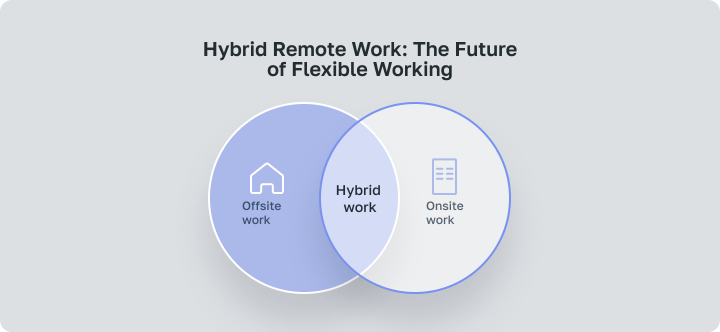
In addition, hybrid work arrangements help companies tap into a broader talent pool. By removing geographic barriers, companies can not only attract talent from different locations, but also benefit from the diverse perspectives and expertise that such a workforce brings. This flexibility is especially beneficial in today’s globalized business environment, where adaptability and diversity are key to innovation and growth.
The role of hybrid remote work is becoming more central, driven by advancing technologies and changing workforce expectations. Adoption of this model is expected to continue to grow as organizations seek more dynamic and responsive work arrangements that can adapt to future disruptions and changes in the workplace climate. This shift to hybrid remote work is not just a temporary adaptation, but is becoming a permanent feature of how organizations operate, with significant implications for productivity, employee engagement, and organizational culture.
In this article, we discuss a hybrid remote jobs meaning with the benefits and challenges of this model, its origins, and some tips for successful hybrid remote work implementation.
Understanding Hybrid Remote Work
Definition and Key Concepts
Allows employees to dynamically split their time between an office setting and another location, typically their home is a representation of what is hybrid remote work. This model is defined by three foundational elements: flexible scheduling, technological connectivity, and location independence, all designed to foster a balance between structured office interactions and the autonomy of remote work.
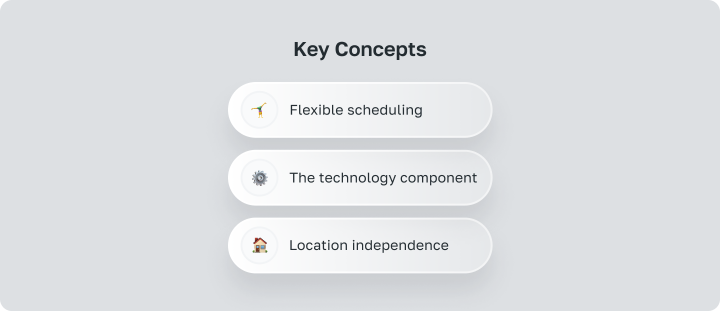
- Flexible scheduling under this model allows employees to choose their work hours within certain limits, facilitating a better work-life balance and potentially increasing job satisfaction while decreasing burnout.
- The technology component is vital for ensuring that team members stay connected regardless of where they are working. Essential tech tools include video conferencing software, real-time collaboration platforms, and project management applications that help bridge the gap between remote and on-site team members.
- Location independence is another significant aspect of hybrid remote work. This flexibility allows employees to choose their work environment, which can be at home, in a traditional office, or any other conducive environment such as a co-working space. This aspect is particularly beneficial in attracting and retaining talent who may prefer not to relocate or commute daily.
Additionally, the hybrid work setup promotes an inclusive workplace culture that can adapt to the varying needs of a diverse workforce. It acknowledges and supports different working styles and personal circumstances, which can lead to higher levels of employee engagement and productivity. Organizations that adopt this model are seen as more progressive and employee-centric, which can enhance their reputation in the job market.
In conclusion, hybrid remote work is not just about where work is done but about creating a more adaptive, responsive, and employee-focused working environment. By effectively integrating the core components of flexible scheduling, robust technological infrastructure, and location independence, companies can maximize both employee satisfaction and organizational productivity. This model represents a significant evolution in the traditional work environment, highlighting a shift towards more dynamic and versatile work practices.
Evolution of Work Models
The concept of hybrid remote work has gained traction as a viable work model, particularly in response to recent global shifts and technological advances that have reshaped cultural attitudes toward work and workplace flexibility. Originally, work models adhered to rigid structures, with employees expected to work set hours in specific locations. This traditional approach was challenged by the digital revolution, which introduced transformative technologies such as the Internet and mobile computing that reshaped how and where work could be performed.
Over time, companies began to explore various flexible work arrangements to improve productivity and employee satisfaction. These included telecommuting and fully remote roles, which allowed employees to work from various locations outside the traditional office. The transition to more flexible models was further accelerated by the need for adaptability during crises, such as public health emergencies, which required maintaining productivity despite significant disruptions to traditional work environments.
Today, hybrid remote work represents an advanced iteration of these evolving employment models, offering a balanced approach that combines the structured environment of office work with the flexibility of remote work. This model supports a variety of work styles and personal circumstances to meet the needs of a broader workforce. It leverages the benefits of both in-office and remote environments to increase collaboration, innovation, and productivity without sacrificing the autonomy and work-life balance that remote work provides.
Hybrid remote work is emerging as a mature solution that not only addresses immediate flexibility needs, but also strategically positions organizations for future challenges as they continue to navigate the complexities of a changing workplace. It underscores a shift toward more dynamic work practices that focus on optimizing work outcomes and employee well-being through adaptable and employee-centric work arrangements. This evolution reflects a broader trend toward workplace transformation, where the integration of flexibility, technology, and employee preferences is critical to fostering an engaging and productive work environment.
Implementing Hybrid Remote Work
Designing a Hybrid Work Environment
Creating an effective hybrid work environment involves a strategic approach that optimizes both remote and in-office work settings to enhance productivity, maintain corporate culture, and support employee well-being. Here’s how organizations can effectively design such an environment:
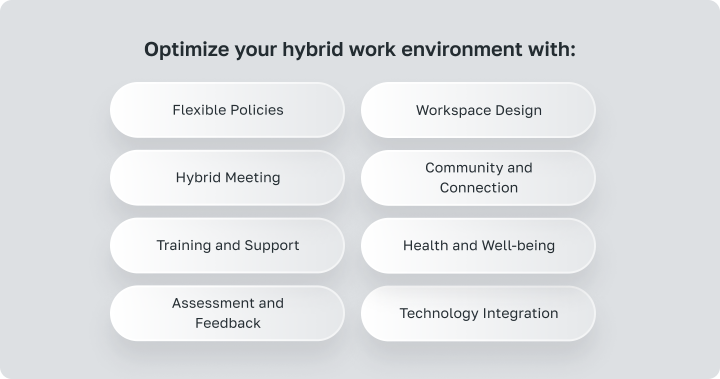
- Flexible Policies: Develop clear, comprehensive guidelines that dictate how and when employees can choose to work remotely or from the office. These policies should consider the nature of the work and the specific roles within the organization, ensuring they cater to various departmental needs while supporting work-life balance.
- Workspace Design: Optimize physical office spaces to foster collaboration and innovation, incorporating open-plan areas for team interactions alongside quiet spaces for focused work. For remote workers, provide support and possibly stipends to assist in setting up a conducive home office environment that mirrors the productivity of the office setting.
- Hybrid Meetings: Equip conference rooms with advanced video conferencing technology to ensure that remote participants can engage as effectively as those in-person. High-quality audio systems, multiple screen setups, and reliable internet connections are essential to facilitate seamless communication across all locations.
- Community and Connection: Foster a strong sense of community by implementing regular virtual check-ins and organizing online social events to ensure that remote employees feel as connected as those in the office. This helps in preserving the organizational culture and enhancing team cohesion.
- Training and Support: Provide targeted training programs that help both employees and managers effectively navigate the hybrid work model. These should cover essential skills such as digital literacy, time management, and effective remote communication. Support should also extend to technical assistance to handle any issues that might arise from using remote working tools.
- Health and Well-being: Promote initiatives that support both mental and physical health, including flexible working hours, ergonomic advice, mental health days, and wellness challenges. It’s vital that employees feel supported in all aspects of their health to maintain productivity and job satisfaction.
- Assessment and Feedback: Regularly assess the effectiveness of the hybrid work model and solicit feedback from employees to continuously refine work policies and the environment. This iterative process ensures the system remains responsive to employee needs and business goals.
- Technology Integration: Leverage technology to create a digital workspace that mirrors the physical office, enabling smooth transitions between the two. Use cloud-based platforms and project management tools to keep resources accessible and workflows transparent.
Technology and Tools for Hybrid Work
The growing popularity of hybrid work arrangements requires robust technology and tools to support seamless communication and collaboration across multiple environments. To effectively implement and manage hybrid work environments, organizations need to deploy a range of technologies that enhance connectivity, ensure security, and facilitate project management.
Project Management Software
Effective hybrid work also depends on robust project management software to keep distributed teams aligned and projects on track. Platforms like Asana, Trello, and Worksection are essential for managing tasks, tracking progress, and allocating resources.
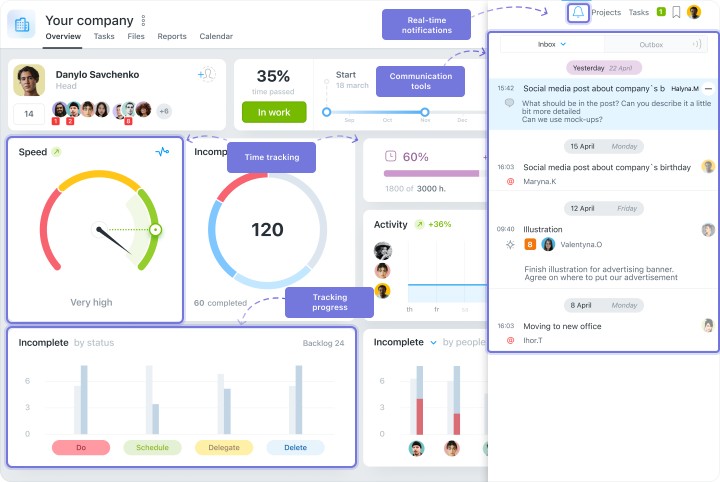
Worksection project dashboard
Worksection, in particular, stands out for its ability to tailor its functionality to different team needs. It offers tools for detailed task planning, comprehensive reporting, and customization for different project needs, making it an invaluable asset for hybrid teams looking to streamline workflows and increase productivity.
Secure Networks
With the shift to hybrid work, ensuring the security of remote connections is paramount. Organizations must implement VPNs, end-to-end encryption, and robust cybersecurity measures to protect sensitive corporate data from potential threats. These security protocols are critical to protecting information as employees access corporate networks from multiple, often unsecured, Internet connections.
Unified Communications Systems
Tools like Slack, Microsoft Teams, or Zoom are critical in a hybrid work environment. These unified communications systems keep teams connected regardless of their physical location.
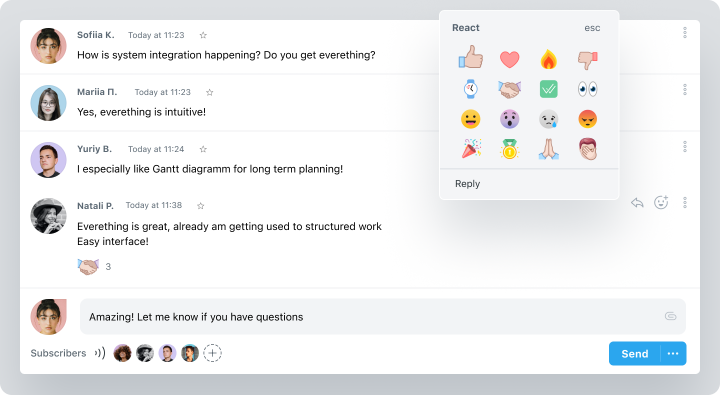
Worksection real-time task communication
Worksection allows for real-time collaboration and communication, with context communication. This makes it essential for maintaining team cohesion and ensuring that all members, whether at home or in the office, feel equally engaged and informed.
Cloud Services
The use of cloud storage and applications ensures that all team members have real-time access to the latest documents and resources. This technology is fundamental to a hybrid work environment, allowing employees to collaborate and access the files they need without the need for physical storage devices or internal network connections. Cloud services not only improve collaboration, but also increase flexibility by allowing employees to work effectively from anywhere.
Digital Onboarding and Training Tools
Integrating new hires into hybrid teams and providing ongoing training can be challenging. Digital onboarding and training tools are essential for delivering consistent and effective training experiences to both remote and in-office employees. These platforms help standardize training processes and ensure that all employees, regardless of location, receive the same information and resources to effectively perform their roles.
Advanced Analytics Tools
To optimize the hybrid work model, organizations should use advanced analytics tools to track productivity, employee engagement, and the effectiveness of the hybrid work setup. Worksection provides valuable insights based on an internal analytics system that can help managers make informed decisions about workflows, team configurations, and resource allocations.
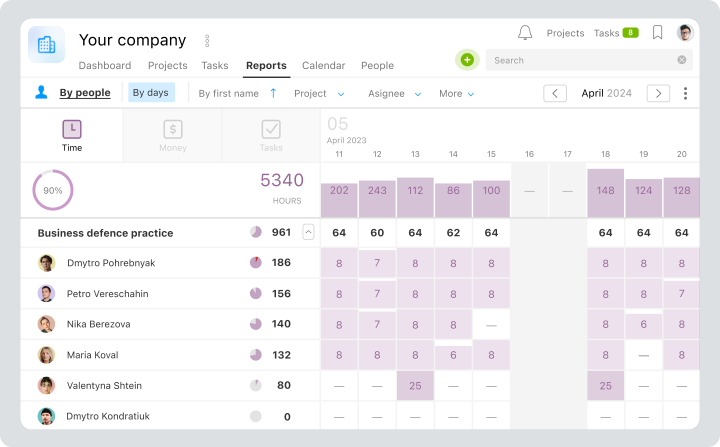
Worksection reports by people
Analytics also play a critical role in identifying areas for improvement and ensuring that the hybrid work model continues to meet the evolving needs of the organization and its employees.
Benefits and Challenges
Advantages of Hybrid Remote Work
Hybrid remote work, which combines in-office and remote work, offers several benefits that improve both the employer and employee experience across industries:
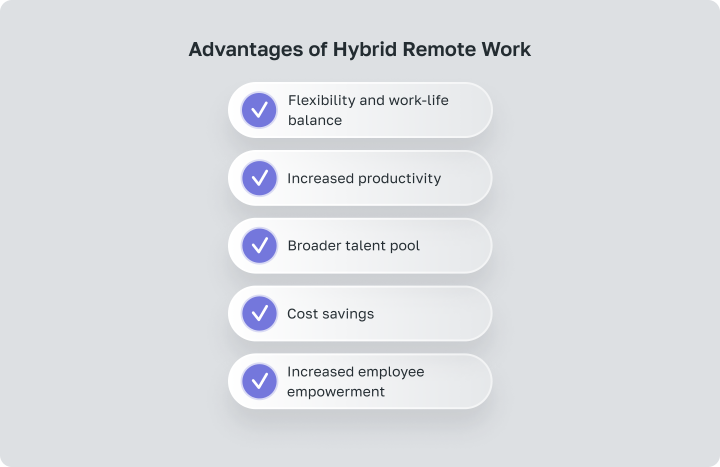
- Flexibility and work-life balance: Hybrid work models allow employees the flexibility to schedule their workdays around personal commitments, improving work-life balance. This adaptability often leads to greater employee satisfaction and retention. Employees can juggle work responsibilities and personal needs without sacrificing productivity, promoting a healthier balance that can lead to a happier and more motivated workforce.
- Increased productivity: Companies often find that hybrid work environments increase productivity. Employees save time that would otherwise be spent commuting, which can be redirected to productive work. This model allows individuals to work in a controlled environment of their choice, whether at home or in a quiet room, during their peak hours of focus, reducing stress and increasing focus.
- Broader talent pool: Hybrid remote work enables organizations to hire from a broader geographic pool, not just those who can commute to a physical office. This flexibility allows companies to access a broader talent pool and select the best candidates based on skills rather than proximity, which can lead to attracting higher quality talent.
- Cost savings: The hybrid work model can result in significant cost savings for organizations. With a portion of the workforce working remotely at any given time, companies can reduce the amount of physical office space required and associated costs such as utilities, office supplies, and facilities management. These savings can then be reinvested in other areas of the business or passed on to customers in the form of lower prices or better service.
- Increased employee empowerment: The hybrid work model fosters a sense of autonomy among employees by allowing them to choose where and when they work. This sense of trust and freedom can boost morale and motivation, leading to greater job satisfaction and loyalty. Autonomy is associated with improved job performance because employees feel more in control of their work environment and schedule.
Overcoming the Challenges
While the hybrid work model offers notable benefits, it also presents specific challenges that organizations must address effectively:
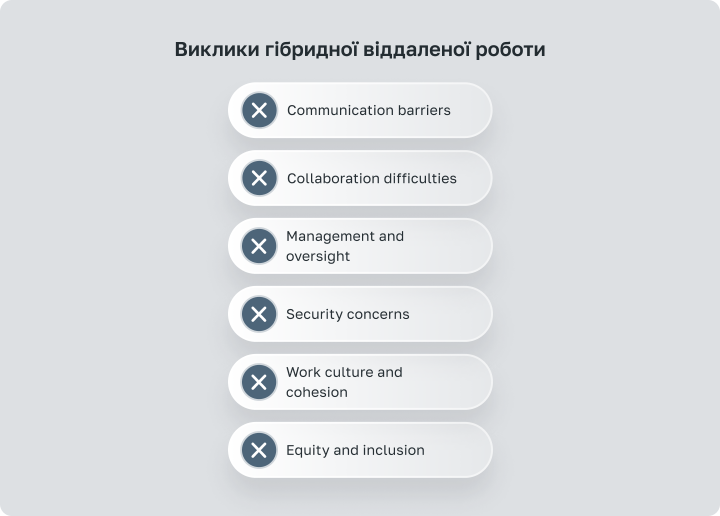
- Communication barriers: Distributed teams can struggle with consistent communication, leading to the potential formation of information silos. Ensuring that remote workers receive the same updates as those in the office is critical to preventing miscommunication and ensuring that all team members are equally informed.
- Collaboration difficulties: Hybrid work environments can hinder seamless collaboration if not managed with the right tools and policies. This can result in project delays or a decrease in innovation as team members struggle to effectively synchronize their efforts.
- Management and oversight: The physical absence of team members can complicate supervision and support, reduce the effectiveness of performance reviews, and potentially lead to weaker team dynamics. Managers must adapt their methods to successfully manage remote supervision.
- Security concerns: The increase in remote access points can increase cybersecurity risks. Organizations need to strengthen their security protocols to ensure that remote access to systems is secure and that confidential data remains protected.
- Work culture and cohesion: Cultivating a robust organizational culture and maintaining team cohesion is challenging when face-to-face interactions are limited. Remote work can lead to a diluted sense of community and decreased employee engagement.
- Equity and inclusion: Remote workers may feel marginalized or overlooked compared to their in-office counterparts, potentially impacting their career development and job satisfaction. This “out of sight, out of mind” issue requires deliberate efforts to ensure that all employees are visible and valued, regardless of their physical location.
By understanding these benefits and challenges, organizations can better prepare to implement or improve their hybrid work models, optimizing both employee satisfaction and organizational productivity.
Case Studies and Real-World Examples
Success Stories in Hybrid Remote Work
Tech Giant’s Hybrid Strategy
A major technology company, renowned for its innovative culture, implemented a hybrid work policy, allowing employees to work from home for three days a week. The flexibility enabled by this policy led to a reported 40% increase in productivity metrics across various departments, and a significant reduction in staff turnover — specifically, a 15% decrease compared to the previous year. This company’s approach emphasized balancing collaborative office days with focus-oriented remote days, optimizing employee engagement and efficiency.
Financial Services Firm’s Flexible Model
A global financial services firm introduced a flexible hybrid work model that was tailored according to daily tasks and team collaboration needs. Employees had the autonomy to choose their workplace — either from home or the office, based on the specific activities planned for the day. This policy improved employee satisfaction regarding work-life balance, directly impacting their performance and loyalty. It also made the firm more attractive to prospective employees, enhancing its talent acquisition.
Retail Chain’s Operational Shift
A national retail chain redesigned its operational strategy to incorporate hybrid work environments. The company reduced its physical retail space requirements by 20% and reallocated these resources towards enhancing online operations and customer service capabilities. This shift not only reduced operational costs but also contributed to a 10% increase in overall sales, attributed to improved staff morale and greater innovative output from teams.
These examples underline how tailored approaches to hybrid remote work can lead to significant organizational benefits across various industries, from technology and finance to retail. Each organization adjusted the hybrid work model to align with its operational needs and employee preferences, leading to enhanced productivity, reduced costs, and improved employee satisfaction.
Lessons Learned and Best Practices
To effectively integrate hybrid remote work models, organizations have gleaned valuable lessons and established best practices that ensure sustainable and productive work environments. Here’s a more detailed expansion of these insights:
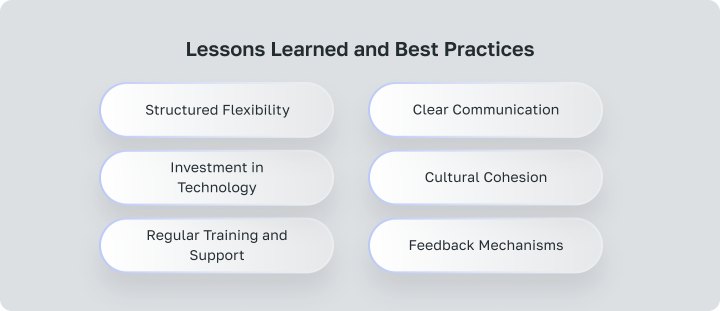
- Structured Flexibility: Organizations have learned the importance of blending flexibility with sufficient structure. Establishing core hours during which all employees are expected to be available facilitates seamless teamwork and minimizes disruptions. This structure supports both synchronous and asynchronous work, allowing for flexibility around these core hours to meet personal or local needs.
- Investment in Technology: A key driver of successful hybrid work environments is the robustness of the IT infrastructure. Companies must invest in secure, reliable, and intuitive technology that supports various functions — from video conferencing and collaborative platforms to project management tools. This technology backbone is crucial for bridging the gap between remote and in-office work, ensuring that all team members have equal access to necessary resources.
- Regular Training and Support: Transitioning to a hybrid work model requires adjustments from both employees and management. Providing continuous training that addresses the specific needs of hybrid workflows, such as managing remote teams, using collaborative tools effectively, and best practices for remote communication, is vital. Support systems, such as IT help desks and HR advisory services, should be readily accessible to address the ongoing needs of the workforce.
- Clear Communication: Clarity in communication is paramount. Organizations must define clear protocols for daily communications, project updates, and performance metrics. This includes setting explicit expectations about deliverables and providing regular feedback to ensure all employees, whether remote or in-office, are aligned with organizational goals.
- Cultural Cohesion: Fostering a unified company culture that encompasses both remote and in-office employees is another critical lesson. Regular virtual social events, hybrid team meetings, and occasional in-person retreats can help maintain a sense of community and belonging, which is essential for employee morale and corporate identity.
- Feedback Mechanisms: Successful hybrid work models thrive on continuous improvement, driven by feedback from all stakeholders. Establishing regular channels for feedback allows teams to express concerns, propose improvements, and share their experiences. This iterative feedback process helps organizations fine-tune their hybrid work models to better suit their evolving needs.
Future of Work: Embracing Hybrid Models
Trends and Predictions
The future of hybrid remote work looks to be a dynamic and evolving, shaped by various significant trends and technological innovations. Here are some expanded insights into what the future may hold:
Enhanced Role of Data Analytics
With the increase in remote work, organizations will likely leverage data analytics more comprehensively to track performance, employee engagement, and productivity. Tools that offer real-time analytics will become essential in managing a dispersed workforce effectively.
Integration of Artificial Intelligence
Beyond just facilitating virtual meetings, AI could play a critical role in optimizing work processes in hybrid work environments. For instance, AI-driven algorithms could be used to schedule work dynamically based on employees’ productivity peaks and personal commitments.
Advanced Security Measures
As hybrid work models inherently increase data vulnerability, organizations will invest more heavily in advanced cybersecurity measures. This will include the adoption of more sophisticated encryption technologies and multifactor authentication systems to secure remote access to company resources.
Emphasis on Equitable Work Practices
The shift towards hybrid models will necessitate a greater focus on creating equitable work practices that ensure all employees, whether they work remotely or in-office, have equal opportunities for advancement and access to resources.
Expansion of Digital Workspaces
Digital workspace platforms will evolve to be more inclusive and interactive, offering features that mimic physical office interactions to strengthen team cohesion and company culture. Virtual reality (VR) and augmented reality (AR) technologies may become more mainstream, used for creating immersive meeting experiences that engage both remote and in-office employees.
By understanding these trends and preparing for them, organizations can harness the full potential of hybrid work models, ensuring they not only adapt to the new normal but also thrive in it.
Preparing for a Hybrid Workforce
To effectively prepare for a hybrid workforce, it’s important for organizations to develop a comprehensive strategy that addresses both the logistical and cultural aspects of hybrid work. Here’s how you can improve your readiness:
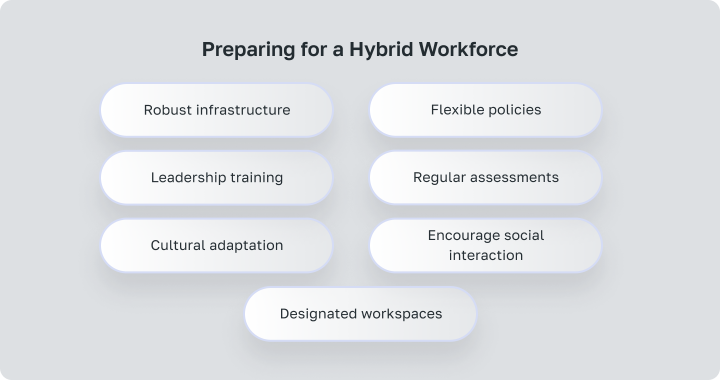
- Robust infrastructure: Building a reliable technology foundation is critical. This includes not only providing secure and efficient communication tools, but also ensuring that all systems, from project management software to virtual meeting platforms, integrate seamlessly. Consider implementing advanced IT support systems to quickly resolve technical issues.
- Flexible policies: Develop detailed but adaptable policies that clearly define expectations for both remote and in-office work. These policies should cover issues such as work hours, availability, and communication protocols, and ensure that they are well understood and easily accessible by all employees.
- Leadership training: Equip managers with the skills needed to manage a distributed workforce. Training programs should focus on fostering trust without direct supervision and emphasize the importance of results over activities. Leaders should learn how to effectively motivate and engage teams that may feel disconnected from the central hub of the organization.
- Regular assessments: Implement a framework for regularly evaluating the effectiveness of the hybrid work model. Use tools to measure productivity, employee engagement, and job satisfaction. Adjustments should be based on empirical data as well as feedback from employees at all levels.
- Cultural adaptation: Develop a culture that supports flexible work arrangements by promoting values such as autonomy, responsibility, and trust among all employees. Highlight successful examples of remote work within the company to normalize and encourage it.
- Encourage social interaction: Encourage informal interactions among team members to replicate the spontaneous conversations that occur in physical offices. This can be done through virtual coffee breaks, online social events, or chat channels dedicated to nonwork related discussions.
- Designated workspaces: For in-office days, consider creating designated spaces that employees can reserve in advance. This helps manage office capacity and ensures that those who come into the office find a productive environment.
Conclusion
Embracing the Hybrid Remote Work Revolution
As we reflect on the hybrid remote work revolution, it’s evident that this model isn’t just a fleeting response to unprecedented times but a transformative shift in the paradigm of work itself. Hybrid remote work has risen from a niche option to a mainstream strategy, reshaping how businesses think about productivity, employee satisfaction, and operational efficiency.
The adoption of hybrid remote work underscores a broader acceptance of flexibility as a fundamental component of modern employment. It offers employees the chance to blend home and office environments in ways that suit their life circumstances and work preferences, which can lead to a more balanced and fulfilling professional life. For employers, the hybrid work model opens up access to a broader talent pool unrestrained by geographical limits, offering a significant competitive edge in acquiring top talent.
Moreover, the hybrid work model encourages companies to innovate in their use of technology and in management practices and workplace culture. The reliance on digital tools has driven advancements in communication technology, project management software, and security protocols, ensuring that remote work is both effective and secure.
However, the transition to hybrid work also requires organizations to navigate potential challenges, including maintaining team cohesion, ensuring equitable treatment for all employees, and managing the complexities of a dispersed workforce. Success in this area depends on continuous adaptation and proactive management strategies that prioritize clear communication and inclusive practices.
Ultimately, embracing hybrid remote work is about more than just accommodating a new trend — it’s about moving forward with a progressive vision for the future of work. Organizations that effectively integrate and support hybrid models are likely to see sustained benefits in productivity, employee engagement, and organizational adaptability, making it a compelling choice for the future.